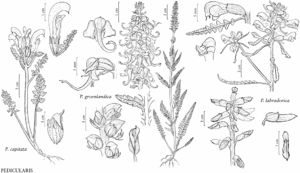Pedicularis labradorica
Eclog. Bot. [2], plate 10. 1778.
Plants 2–25 cm. Leaves: basal 2 or 3, blade lanceolate, 10–20 x 2–3 mm, 1- or 2-pinnatifid, margins of adjacent lobes nonoverlapping, serrate, surfaces glabrous; cauline 1–4, blade linear to lanceolate, 10–50 x 2–10 mm, undivided or 1- or 2-pinnatifid, margins of adjacent lobes nonoverlapping, serrate to 2-serrate, surfaces glabrous or sparsely downy to hispid. Racemes paniculate or buds present in cauline leaf axils, 1–8, exceeding basal leaves, each 5–20-flowered; bracts linear to narrowly lanceolate, 7–15 x 1–2 mm, undivided or 1-pinnatifid, proximal margins entire, distal 1- or 2-serrate, sometimes crenulate, surfaces glabrous or hispid. Pedicels 0.5–2 mm. Flowers: calyx 5–8 mm, glabrous, lobes 2, triangular, 0.5–1.5 mm, apex entire, sometimes slightly bifurcate, glabrous; corolla 12–18 mm, tube deep yellow, 7–10 mm; galea dark yellow or yellow tinged with purple or spotted, 5–9 mm, beakless, margins entire medially, 1-toothed distally, apex arching over abaxial lip; abaxial lip dark yellow, 5–7 mm. 2n = 16.
Phenology: Flowering Jun–Aug.
Habitat: Open forests, tundras, heathlands, rocky slopes, muskegs.
Elevation: 300–1100 m.
Distribution
Greenland, Alta., B.C., Man., Nfld. and Labr. (Labr.), N.W.T., Nunavut, Ont., Que., Sask., Yukon, Alaska, Asia (China, Russia).
Discussion
The flowers of Pedicularis labradorica are usually yellow or dark yellow, and the galea is tinged distally with red or purple; sometimes, the yellow color of the tube abruptly transitions into red or purple. Hultén based var. sulphurea on the solid yellow color variant from the Yukon.
Selected References
None.
